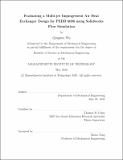Evaluating a multi-jet Impingement air heat exchanger design for PEBB 6000 using Solidworks Flow Simulation
Author(s)
Wu, Qingmei,S.B.Massachusetts Institute of Technology.
Download1196823625-MIT.pdf (3.590Mb)
Other Contributors
Massachusetts Institute of Technology. Department of Mechanical Engineering.
Advisor
Thomas R. Consi.
Terms of use
Metadata
Show full item recordAbstract
The Power Electric Building Block (PEBB) 6000 is a shipboard power converter unit developed by the Navy's Electric Ship Research and Development Consortium (ESRDC). Cooling strategies for the PEBB 6000 are constrained by its size, accessibility, and high heat flux. This paper proposes an air heat exchanger design that combines a parallel plate-fin heat sink with air jet impingement onto its fins. Previous studies showed that jet impingement methods can yield heat transfer rates that are three times of those produced by conventional cooling methods, which confines a parallel flow to a surface. In order to evaluate the design feasibility of a multi-jet impingement air heat exchanger, this paper simulates the temperature contours and the flow trajectories for various multi-jet impingement models using SOLIDWORKS Flow Simulation in two stages. First, multi-jet impingement models with varying number of nozzles, nozzle diameters, impingement heights, arrangements, and velocity configurations were simulated for a single parallel plate fin. Cooler fin temperatures were achieved with larger diameter size, smaller impingement height, higher inlet velocity, and more nozzles. In the second stage, a model for the multi-jet air heat exchanger was created. When compared with simulation results for the heat sink with conventional parallel air flow, the fin thermal resistance of the heat sink was reduced by approximately 60 percent and the heat transfer rate was increased by almost threefold with the multi-jet impingement heat exchanger setup. These results help assess the potential of using a multi-jet impingement heat exchanger to cool the PEBB and provide valuable insight to improve future models.
Description
Thesis: S.B., Massachusetts Institute of Technology, Department of Mechanical Engineering, May, 2020 Cataloged from the official PDF of thesis. Includes bibliographical references (page 59).
Date issued
2020Department
Massachusetts Institute of Technology. Department of Mechanical EngineeringPublisher
Massachusetts Institute of Technology
Keywords
Mechanical Engineering.